Friday night’s game against Brisbane was always going to be a test for the Parramatta Eels. Facing the competition leaders in Darwin on a short turnaround was always going to be tough, but the Eels made it tougher on themselves with simple errors and were obviously exhausted early.
If you want to read a full recap of the game, friend of the site Liam of The Maroon Observer has a tremendous write up that I’d suggest reading. I’d also highly suggest subscribing to his substack as he’s putting out at least 4 pieces of content per week, and if you know the high quality of work Liam produces, you’ll understand how much quality writing will end up in your inbox each week.
Back to the Eels though. Some regular Eye Test readers may know that the Parramatta Eels are the official team of the Eye Test, although I’ve tried not to make it explicitly known, other than my eternal love for all things Daniel Alvaro.
I’ve tended not to cover the Eels too much on the site over the years, as I felt being impartial was a difficult task due to years of frustration watching them.
Any significant length of time supporting Parramatta breeds a rare level of pessimism. You know there’s a disappointment coming no matter how well they’re doing, you just don’t know what form it will take. And when things are bad, everything feels significantly worse than it is. The fleeting joys are usually short lived.
But I’ve seen enough this season that I’ve had to look into what the problems are.
At a surface level, letting go of the only first grade hooker they’ve developed internally in the past forever seems sub optimal. Reed Mahoney wasn’t perfect and has his obvious flaws – currently leading the NRL in missed tackles (13 ahead of second place!) and penalties conceded (and was 2nd last year) – but you can’t deny he was a good fit for what the team wanted to accomplish with the ball.
Josh Hodgson was a tremendous hooker during his career, and the fact he’s been able to return from multiple serious knee injuries is a testament to his strength and determination. But at 33 those same flaws Mahoney has are magnified tenfold with Hodgson, especially playing alongside middles who tend to play longer stints than needed with a coach who hoards interchanges until they’re no longer needed. I’ll get to the Hodgson elephant in the room later.
Equally allowing Isiaah Papali’i walk despite being arguably the finest edge back rower in the competition, to the Tigers of all places, still seems baffling at best. J’maine Hopgood looked like the buy of the season after a few rounds, but it turns out that fantasy points are useless. The good news is that he’ll turn 24 in May and is about to enter his physical prime and he should be a part of the Eels pack for many years.
I understand the need to secure their starting props long term, and Junior Paulo and Reagan Campbell-Gillard have been two of the best around. However, given the paucity of quality dummy halves and the impact a strike backrower can make on a game compared with the relative contribution of starting middle forwards, the value just doesn’t seem there. And then there is the loss of bench depth with Oregon Kaufusi and Marata Niukore moving on, which has been evident early in the season. But what is done is done, their bed is made, and they must live with it.
Given the changes to their team, it would be difficult for the Eels to be as successful playing the way they have been in prior years. They’ve not been dealt the best draw either, with multiple games against teams coming off the buy followed by the short turnaround game in Darwin.
When I have covered the Eels previously, I’ve noted their very obvious Achilles heel. When they have the majority of possession, they make metres quite well through the middle of the field. But when they’re unable to maintain that strong possession percentage, teams can consistently find metres (especially up the middle of the field) and the Eels are often gassed early in games to a point where they can’t contain them.
This was evident last season when I noted how their average distance per set conceded was one of the worst in the league. They had no issues making metres but couldn’t stop opponents once they gained some momentum. This tends to point to teams working them over through the middle of the field, to the point where players start dropping off tackles or gaps open up as tired defenders can’t cover space laterally to close them.
The fact they made it to the grand final in spite of this weakness is a testament to their attack and ability of control field position. But as mentioned, when they meet a team who doesn’t allow them that domination, they tend to crumble.
This the possession ponzi I’m talking about. If your ability to dominate games requires an endless infusion of possession and extra sets, eventually someone is going to be left holding the bag. And it’s looking like the 2023 Eels are the ones holding it right now.
Parramatta aren’t getting downfield like they are accustomed to, their metres per run this season are the lowest in the NRL. Usually, I like to set the scene for these team deep dives with a look at their margins over the course of game, but this time I’m going to get start at the root cause.
Below is the average metres per run this season for all 17 NRL clubs for season 2023. As usual all stats are from Fox Sports Stats. Note due to ANZAC day games this season falling on a Tuesday, this only contains the first six games from Round 8, which is we’re using averages.
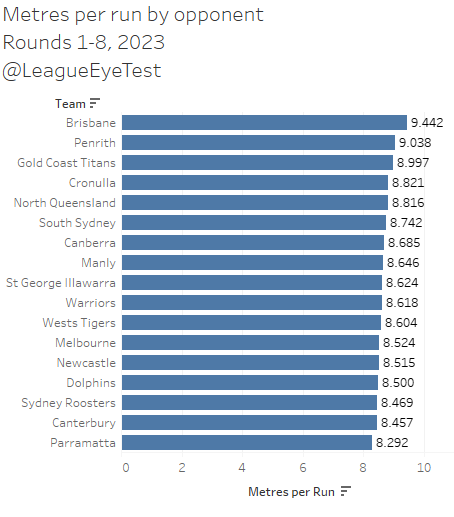
Here’s where you can see the cracks in their ponzi scheme. The Eels average just 8.29 metres per run, lower than the Bulldogs (8.46). That mark is over 1 metre per run lower than the Broncos, and 70 centimetres per run behind Penrith.
Over the course of a game with an average of 135 play the balls, that can add up to almost 100 metres per game fewer that the Eels would gain under the same circumstances as Penrith, and nearly 150 meters fewer than Brisbane.
The reason this matters is that the Eels allow 8.98 metres per run, 68 centimetres per run more than they make themselves, as seen below.

For every two sets of six Parramatta and their opponents have, the Eels will around a run full of 8.3 metres behind. Here’s the net metres per run chart showing that the Eels are last in the NRL for this metric.

Again, this shows that on average, only by consistently having more possession can they end up with better field position than their opponents.
This is where the foundation of their ponzi scheme has crumbled. In 2022, Parramatta averaged 31.6 complete sets per game, second in the competition behind (no prizes for guessing) Penrith at 34 per contest. This year the number hasn’t dropped dramatically, down to 30.4, although it places them 10th among the 17 NRL clubs.
Last year Parramatta opponents averaged just 27.6 complete sets per game, 4th lowest in the league. This year? 30.8 complete sets per game, 9th in the competition.
These don’t sound like significant changes, and they aren’t. What has changed is when they’re getting these complete sets. Below is the difference between complete sets in the first half (blue dot) and second half (orange dot), with the grey line representing the difference. And it’s where you’ll see the the cracks forming.

The Eels have the second lowest average of complete sets in the first half, at 14.4 and only marginally ahead of the injury ravaged Bulldogs at 14.3. For the blue and gold, last season that number was 16.4, two whole complete sets more possession than they’re averaging this year in the first 40 minutes.
One reason for this is that they’re shooting themselves in the foot early in games. Slightly over one quarter of their errors this season have occurred inside the first 16 minutes of a game, with 12% of them happening between the 10th and 16th minutes alone.
In play the ball numbers, this equates to the Eels playing the ball 236 times in the first 20 minutes, but allowing their opponents to have 274. If you’re already relying on winning the possession battle to stay in games, then giving it away so freely early on isn’t the path to success.
Back to the prior chart, the second halve complete sets are a little better, where they rank 7th in the competition, but by then the damage is mostly done. They’re not getting downfield, they’re not controlling possession and they’re letting their opponents make more metres than they are. The only way they’re succeeding is by having more ball, not making better use of it.
Which brings us to how their scores are tracking minute by minute, with the Eels average margin by minute chart below, with 2023 highlighted.

It actually looks not bad? Their average margin after 80 minutes is positive at 0.75, and they never dip below -3.25 which happens in the 72nd minute. But some of that is being masked by their 30-4 win over Canterbury. How does it look if we remove that game?
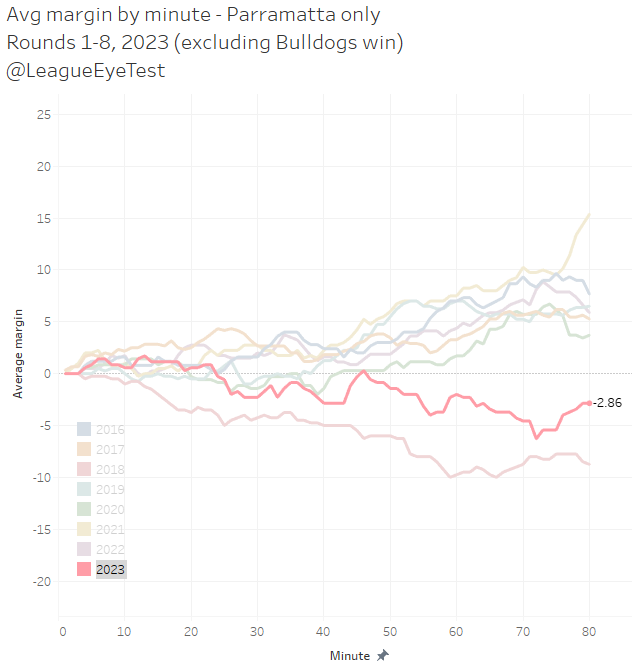
The answer is far less flattering. There’s a steep drop in margin after the 23rd minute (probably right when Paulo and Campbell-Gillard are tiring) where the average drops from +0.86 to -2.0 in three minutes. From there, other than a brief push above 0 in the 46th minute at 0.29, the Eels average margin remains negative before finishing at -2.86 after 80 minutes.
Either line ends up being the second worst start to a season for average margin by the Eels, only ahead of their disastrous 2018 campaign. And the line again highlights that the average margin dips as each half progresses, another indication that players may be fatiguing faster than their opponents.
This lack of movement downfield shows in their percentage of play the balls inside 20 metres, where Parramatta is seeing their lowest number since 2014. Just 15.7% of their play the balls occur inside an opponents red zone, down from 20.6% last year. Their time in the rest of an opponents half has also dropped from 29% to 23%.
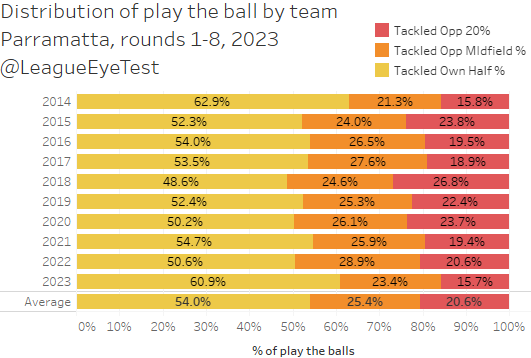
What they are doing is spending more time coming out of their own half, at 61% of total play the balls. They are one of just three teams at 60% or higher, along with Canterbury (you might be noticing a trend here) and Newcastle. That is not the company you want to keep if you expect to make the top eight.
The below chart is sorted by % of time spent inside 20 metres.

The positive is that they’re only allowing 14.3% of opponent play the balls inside their own 20 metre zone. They’re also making opponents spend 62.5% of play the balls coming out of their half. The chart by opponents can be seen below.
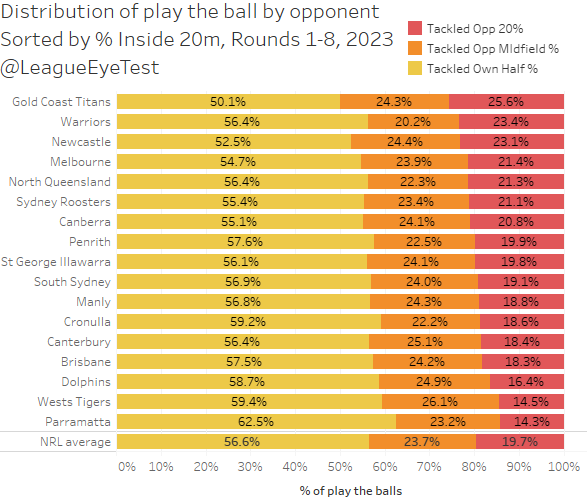
Both numbers are the best in the NRL this season. Whilst they can’t get into attacking positions as easily as prior, they’re also limiting their foes in doing so and ensuring most of the game is being played between the red zones.
And that might give a clue as to why they’re tiring and struggling as each half progresses. Below is a heat map of play the balls by Eels opponents this year.

You’ll note the intensity of the red areas through the middle of the field. No other team in the league has a similar heat map intensity in the middle of the field as Parramatta. It’s quite clear they’re being worked through the middle more than other teams to make their big middles work harder and more often, hoping the payoff comes later.
Just for reference, here’s the heat map of teams playing the Tigers, who have a similar opponent play the ball profile.
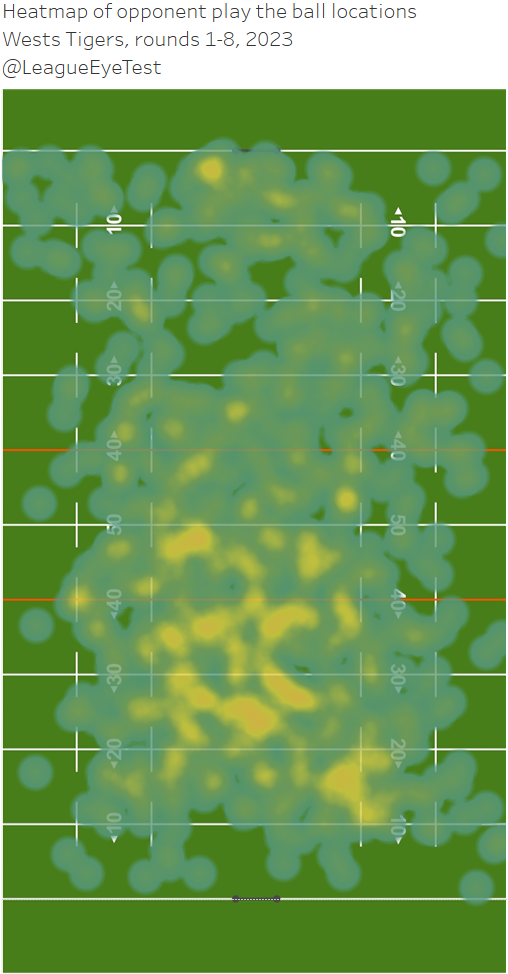
You can see a far more even distribution of play the ball locations as they move down the field. It also shows how percentages can distort things, as even though the Tigers have similar percentages to the Eels they’ve faced nearly 200 play the balls fewer on account of standing under the own goal posts more than their opponents. Playing nearly 500 minutes without leading across seven games will do that.
The other issue for Parramatta is that they’re constantly starting sets too close to their own try line. Here’s the average location of the first play the ball in a set by team this season.
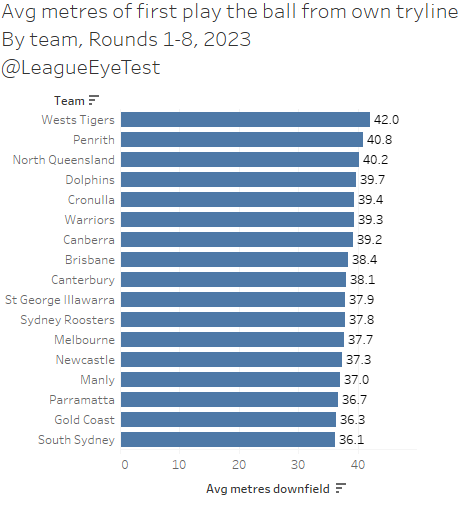
The Eels first play the ball occurs on average just 36.7 metres out, only ahead of the Gold Coast and South Sydney. We established previously that Parra generate fewer metres per run than any other team in the league, so here is another instance of how they’re handicapping themselves. By starting further back and having shorter runs than anyone else, they’re going to be further away from an attacking phase of play than every other team. Again the risk of running a possession ponzi.
But as noted above they’re still controlling field position. Their opponents are only starting 35.6 metres out, third best in the NRL and only slightly behind the Panthers at 35.5.

This is where the long kicking game of Mitch Moses pays off. Even if they can’t get as far downfield as they’d like with the ball, they can make sure Moses puts them as close to the goal line as possible with an end of set kick.
The last reason for their possession struggles is that their games tend to be officiated quiet openly, with just over 10 penalties called per game. The chart below shows the average number of penalties conceded (orange) and awarded (blue), sorted by penalties awarded.

Parramatta’s 4.8 conceded per game is the lowest in the NRL, and their 5.4 awarded ranks 13th. The result is neither team getting as many leg ups down field, but also fewer stoppages which could be compounding their fatigue issues.
Finally back to Josh Hodgson. Looking at my Eye Test Player Contribution Rating (ETPCR), here are the bottom 20 players average rating for the 2023 season.

Using this metric, Hodgson has been worth -2.397 points per .5average game (270 play the balls) this season, 3rd worst in the NRL. That’s quite a feat when most players in this list are outside backs or halves who are playing 80 minutes. Keep in mind the negative side is mostly missed tackles, try causes, line break causes, errors and penalties conceded.
And here’s a breakdown of Hodgson’s career since 2014. It’s not pretty.
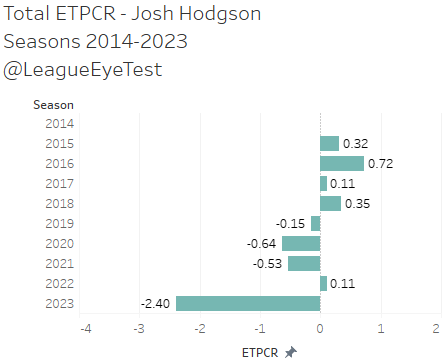
It’s pretty evident now that his negatives far outweigh any positive contribution he’s making, and probably why he wasn’t seen on field past the 31st minute of Friday’s game. There may be value in him playing more limited minutes in Brendan Hands’ role off the bench, with the younger player taking the starting dummy half role. This would allow Hodgson to attack against tired defenders, instead of becoming one himself. Either way his liability in defense can’t be ignored any longer.
You’ll also note that Mahoney isn’t setting the world on fire at Canterbury either, as the issues he had with the Eels are evident in the blue and white. And hands up who had John Bateman as not only a net negative player in 2023 but in the bottom 10?
This might sound like doom and gloom for the Eels, but the issues are fixable and there’s plenty of time to remedy them. The other positive is that this NRL season is one of the closest in many years, the Eels upcoming draw is favourable and they sit just two points outside the top eight with a positive point differential.
On the negative side, Arthur has been slow to make these necessary adjustments early in the season. It’s not easy just to create more possession, but by simply taking care of the ball early they’d be giving themselves a fighting chance rather than coughing it up early after scoring themselves. Hopefully they don’t get caught holding the bag.
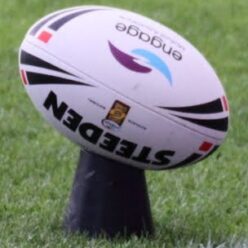
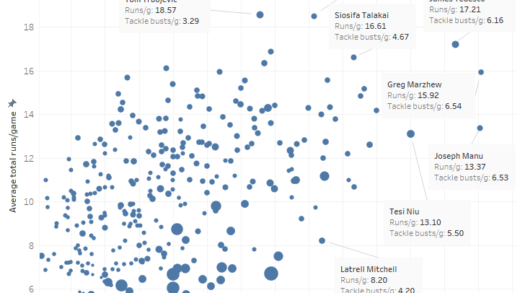

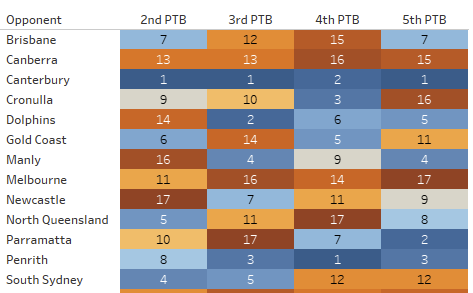
Thank you for your hard work, and diligence in putting this together. Its great content, seems obvious when its all laid out clearly, and certainly matches what can be seen on the field.
Would you consider a post highlighting a few potential roster filling recruits to assist the eels in remedying the situation? The top 30 (27 at present) needs help….
Thank you for the research and hard work. It is appreciated.
Great post. I think we are really missing the oomph up and around the middle that the likes of Niukore, Kaufusi and Papali’i provided. I think Hands will be serviceable at minimum and possibly quite decent, so we need to shore up our second rowers and get a meter-eater outside back to start our sets (it has never really been Sivo’s strong suit)
For now, Moses’ kicking game is about the only thing keeping us in the contest.